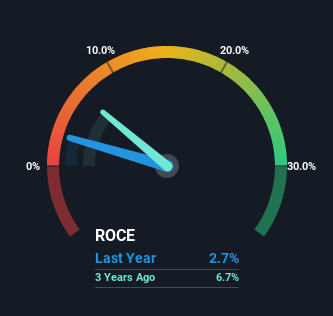Investors Will Want Newmark Security's (LON:NWT) Growth In ROCE To Persist
Did you know there are some financial metrics that can provide clues of a potential multi-bagger? Amongst other things, we'll want to see two things; firstly, a growing return on capital employed (ROCE) and secondly, an expansion in the company's amount of capital employed. Put simply, these types of businesses are compounding machines, meaning they are continually reinvesting their earnings at ever-higher rates of return. So on that note, Newmark Security (LON:NWT) looks quite promising in regards to its trends of return on capital.
Return On Capital Employed (ROCE): What Is It?
Just to clarify if you're unsure, ROCE is a metric for evaluating how much pre-tax income (in percentage terms) a company earns on the capital invested in its business. To calculate this metric for Newmark Security, this is the formula:
Return on Capital Employed = Earnings Before Interest and Tax (EBIT) ÷ (Total Assets - Current Liabilities)
0.027 = UK£284k ÷ (UK£19m - UK£8.0m) (Based on the trailing twelve months to April 2023).
Thus, Newmark Security has an ROCE of 2.7%. Ultimately, that's a low return and it under-performs the Electronic industry average of 13%.
See our latest analysis for Newmark Security

Historical performance is a great place to start when researching a stock so above you can see the gauge for Newmark Security's ROCE against it's prior returns. If you'd like to look at how Newmark Security has performed in the past in other metrics, you can view this free graph of past earnings, revenue and cash flow.
What Can We Tell From Newmark Security's ROCE Trend?
The fact that Newmark Security is now generating some pre-tax profits from its prior investments is very encouraging. Shareholders would no doubt be pleased with this because the business was loss-making five years ago but is is now generating 2.7% on its capital. And unsurprisingly, like most companies trying to break into the black, Newmark Security is utilizing 49% more capital than it was five years ago. We like this trend, because it tells us the company has profitable reinvestment opportunities available to it, and if it continues going forward that can lead to a multi-bagger performance.
On a separate but related note, it's important to know that Newmark Security has a current liabilities to total assets ratio of 43%, which we'd consider pretty high. This effectively means that suppliers (or short-term creditors) are funding a large portion of the business, so just be aware that this can introduce some elements of risk. Ideally we'd like to see this reduce as that would mean fewer obligations bearing risks.
What We Can Learn From Newmark Security's ROCE
To the delight of most shareholders, Newmark Security has now broken into profitability. Since the stock has returned a staggering 108% to shareholders over the last five years, it looks like investors are recognizing these changes. In light of that, we think it's worth looking further into this stock because if Newmark Security can keep these trends up, it could have a bright future ahead.
On a final note, we found 2 warning signs for Newmark Security (1 doesn't sit too well with us) you should be aware of.
While Newmark Security may not currently earn the highest returns, we've compiled a list of companies that currently earn more than 25% return on equity. Check out this free list here.
Valuation is complex, but we're here to simplify it.
Discover if Newmark Security might be undervalued or overvalued with our detailed analysis, featuring fair value estimates, potential risks, dividends, insider trades, and its financial condition.
Access Free AnalysisHave feedback on this article? Concerned about the content? Get in touch with us directly. Alternatively, email editorial-team (at) simplywallst.com.
This article by Simply Wall St is general in nature. We provide commentary based on historical data and analyst forecasts only using an unbiased methodology and our articles are not intended to be financial advice. It does not constitute a recommendation to buy or sell any stock, and does not take account of your objectives, or your financial situation. We aim to bring you long-term focused analysis driven by fundamental data. Note that our analysis may not factor in the latest price-sensitive company announcements or qualitative material. Simply Wall St has no position in any stocks mentioned.
About AIM:NWT
Newmark Security
Designs, manufactures, and sells electronic and physical security systems in the United Kingdom, the United States, Belgium, Canada, the Netherlands, Mexico, the Middle East, Sweden, Switzerland, Ireland, and internationally.
Solid track record with adequate balance sheet.
Market Insights
Weekly Picks

Solutions by stc: 34% Upside in Saudi's Digital Transformation Leader


The AI Infrastructure Giant Grows Into Its Valuation
Recently Updated Narratives

Perdana Petroleum Berhad is a Zombie Business with a 27.34% Profit Margin and inflation adjusted revenue Business
Many trends acting at the same time


Engineered for Stability. Positioned for Growth.
Popular Narratives


MicroVision will explode future revenue by 380.37% with a vision towards success


NVDA: Expanding AI Demand Will Drive Major Data Center Investments Through 2026



